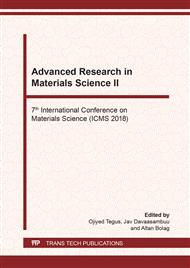p.98
p.104
p.113
p.119
p.124
p.130
p.135
p.140
p.148
Effect of SiH4 Flow Rates on the Structures and Properties of Si-Rich Silicon Nitride Films Prepared by Hot Wire Chemical Vapor Deposition
Abstract:
Silicon-rich silicon nitride thin films were deposited on the P type (100) of silicon and Corning7059 glass by hot-wire chemical vapor deposition method using SiH4 and NH3 as reaction gas source. The effects of SiH4 flow rate on the structures and optical properties of the thin films were studied under optimizing other deposition parameters. The structures, band gap width and surface morphology of the thin films were characterized by Fourier transform infrared absorption spectroscopy (FTIR), ultraviolet-visible (UV-VIS) light transmittance spectra and scanning electron microscope (SEM), respectively. The experiment results show that, with increasing of the SiH4 flow rate, the content of N and Si atoms in the thin films increases, and the Si-N bond density increases gradually, and the optical band gap of the films shows a trend of increasing. When the silane flow rate is less than 0.9sccm, there is no Si-H bond stretching vibration absorption peak, and silicon atoms mainly bond with nitrogen atoms. As the SiH4 flow rate decreases, silicon clusters embedded in silicon nitride matrix gradually become smaller. When SiH4 flow rate is 0.4sccm, we prepared the silicon cluster nanoparticles with an average diameter of about 50nm embedded in silicon nitride thin films matrix. Therefore, properly reduction of the SiH4 flow rate is favorable for preparing the smaller silicon cluster nanoparticles in silicon rich silicon nitride thin films. The results lay the foundation for the preparation of silicon quantum dots thin film materials.
Info:
Periodical:
Pages:
135-139
Citation:
Online since:
March 2019
Authors:
Price:
Сopyright:
© 2019 Trans Tech Publications Ltd. All Rights Reserved
Share:
Citation:


